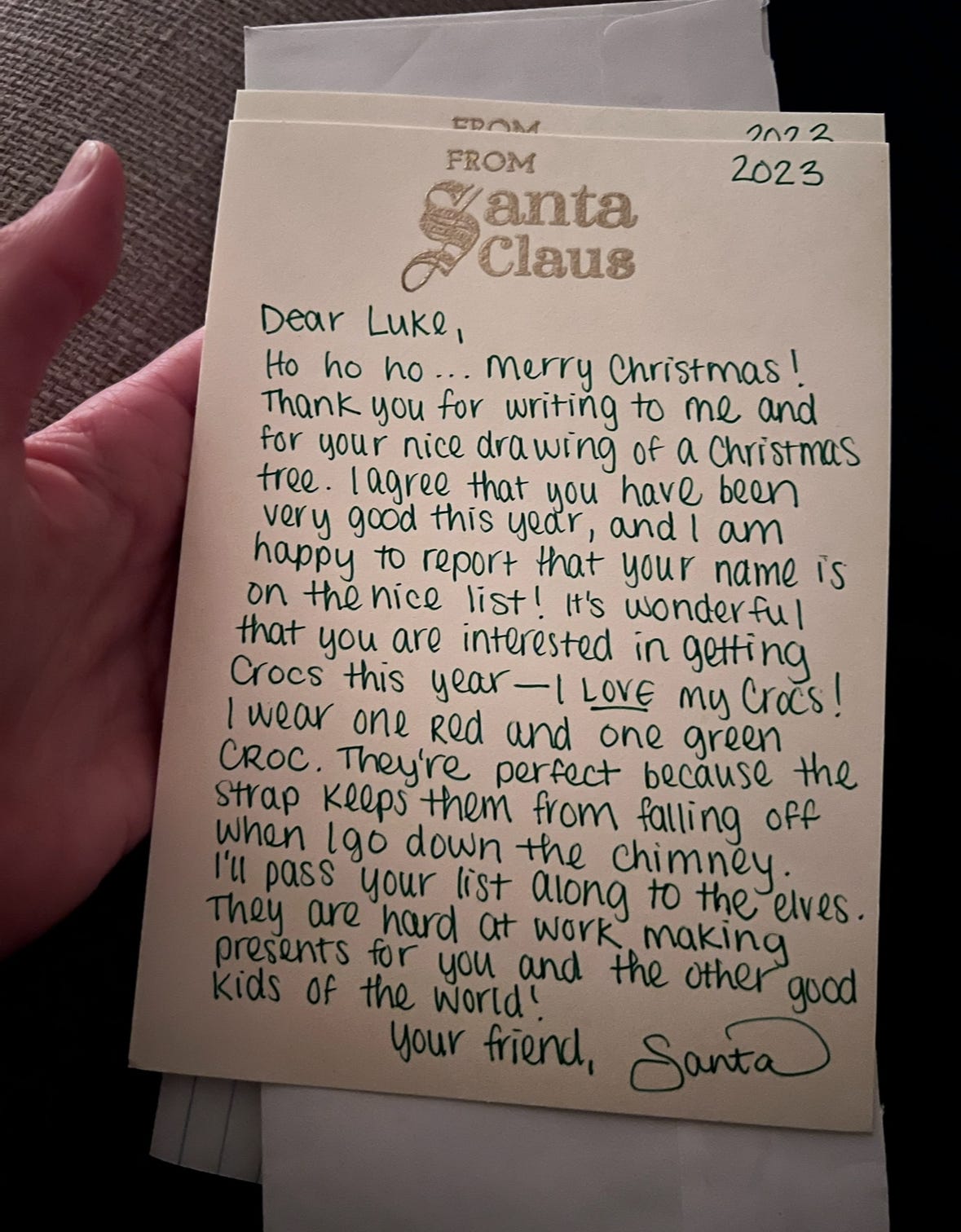I was Santa's Ghostwriter
And it was an exercise in holding grief, magic, and a gel pen (all at the same time).
In my seven years of ghostwriting novels and memoirs, I’ve had the honor of writing for some extraordinary people. I’ve worked with best-selling novelists and Olympic gold medalists, reality TV stars and millionaire entrepreneurs, but never once could I have imagined that I’d land a job ghostwriting for Santa Claus.
Before you get excited, we aren’t getting a gritty tell-all memoir from St. Nick—not that I’m working on, anyway. There is no long-awaited sequel to The Night Before Christmas, and the North Pole isn’t outsourcing the naughty and nice lists. The business we’re dealing in is letters.
As you can imagine, Santa receives thousands of letters every holiday season from kids all over the globe, most of which go without a response. The man in red is much too busy running operations at the North Pole and gearing up for the most excruciating delivery route on record to write back to the children of the world. Unless, of course, you drop your letter in the right mailbox.
The mailbox isn’t up year round—Santa would get too much junk mail if it were. Instead, the little tin mailbox marked “North Pole Post” appears after Thanksgiving in front of Santa’s secret second home outside of the North Pole, which is, of course, in a suburb of Chicago. This year, Santa happened to be out of town for Thanksgiving, so he called in a favor, and I was the one who hauled the mailbox out to its home near the sidewalk. I broke one of the four stakes driving it into the slightly-frozen ground, but Santa, who was watching me on his Ring camera, said I installed it in the right place. Not bad for an elf in training, but I wanted to play a larger role. I wanted to help respond to the letters, which arrived by the handful the very next day. Santa and I found a date for me to come out to the suburbs to help, and thus began my seasonal job as Santa’s ghostwriter.
“This wasn’t a book for some businessman; these were Santa letters for children. This wasn’t capitalism. This was magic.”
On a warm Sunday in mid-December, I parked in front of Santa’s house feeling uncharacteristically nervous. I’ve met with dozens of clients, and very few have ever been anything short of wowed by my ability to adopt their voices and tell their stories. I’d call myself an expert in it, really, so what was there to be nervous about? Plus Santa is a good friend of mine. If it turned out that I wasn’t a jolly enough writer for the job, he’d probably lie to me and say I was doing fine, then redo all the work himself, and I’d be none the wiser. But, despite this being an unpaid job, the stakes felt higher than any five figure projects I’ve worked on. This wasn’t a book for some businessman; these were Santa letters for children. This wasn’t capitalism. This was magic.
Of course, like most magic, it was all hard work behind the scenes—most of it done by Santa, not me. I wasn’t the one who stamped hundreds of pieces of custom stationery, nor was my credit card used to buy stickers, red and green gel pens, and all the supplies for wax seals. My dining room wasn’t the one transformed into a satellite location for Santa’s workshop, and I certainly wasn’t the mastermind who developed the system for sorting and responding to hundreds of letters by hand. But I folded myself into the bustle of the workshop, ready to play my small part.
Santa passed me a template along with a few sample letters, but he assured me I could go off-script so long as I followed two important rules: 1. Don’t promise any presents and 2. Sign off every letter with “Your friend, Santa,” never “Love, Santa.” Just to be safe. We were writing to minors, after all. With a lap desk, a fountain pen, and a curated Christmas playlist, I wrote my first letter, then read it aloud for Santa’s approval before moving along to my second and third. Before long, I was promoted to writing letters for multi-child families—the sibling and cousin letters were bundled together, per Santa’s system, so the responses were all in the same handwriting. Brilliant.
Each letter brought something new and occasionally something confusing. Some children sent drawings while others got straight to the point with a Christmas list. Personally, I liked the curious kids who seized their rare opportunity to get the inside scoop on Santa. What’s his favorite color? What does he do in the off-season? Does he really live on a diet of Christmas cookies alone? I recalled asking similar questions back when I wrote letters to the Tooth Fairy, and she answered every one, bless her heart. How karmically fair, then, that I was on the receiving end of those types of questions. I owed it to…someone. Probably my mother, dedicated Tooth Fairy ghostwriter that she was.
“The story behind the Santa letters isn’t mine to tell, but I hope Santa won’t mind if I share with you that it’s a story born from grief.”
In three or four hours, I wrote dozens of letters, addressed envelopes with loopy cursive, and invented stories about Blitzen visiting the workshop only to be buried beneath a pile of Squishmallows. Of all the writing projects I’ve worked on in the last seven years, this was by far my favorite, and certainly the most surprising. For one, why did an alarming number of Christmas lists include a request for a punching bag? Also, why were six-year-olds asking for skin care? When I opened a letter from a family whose Daddy had gone to heaven that year, Santa requested I hand that one directly to him, and I watched, teary eyed, as he wrote three unique responses—one to each child, plus one to the mom.
The story behind the Santa letters isn’t mine to tell, but I hope Santa won’t mind if I share with you that it’s a story born from grief; that the homemade stationery was made with stamps Santa’s mother left behind when she died, and the whole letter writing scheme came about during Santa’s first Christmas without her. That’s all I’ll say about it, though. Santa will tell you the rest someday.
This Christmas, I went back to the suburbs to stay with my parents, and when I needed a break from family, Santa needed help responding to the final letters of the season. In retrospect, my mother could’ve used a little more help, too. There’s never any shortage of things to get done around the holidays. On Christmas Eve, while Mom was busy prepping monkey bread for the next morning’s breakfast and making a charcuterie wreath to bring to Grandma’s for dinner, I stepped out to walk the dog and found a gift bag sitting on my windshield. Inside was a letter from Santa, thanking me for my hard work this season, but it didn’t seem like there was really much to thank me for. All I did was write a couple dozen letters; Santa was the one who really made it happen. Year after year, he was the one who chose to face his grief with a little bit of magic.
I know that the holidays can be horrible for people who are grieving, but I love to pretend that it will never be me. I complain about my parents as though I’ll always have them. I assume there’s always next year. But I know I am not exempt, and my Mom—unlike Santa—won’t live on just because I believe in her. I jokingly remind her all the time that she will never die, and she more earnestly reminds me of the three different places she’d like her ashes scattered. This is what we do: we plan, but we also pretend we don’t have to, and we make magic and memories together while we can.
One Christmas—hopefully many, many Christmases from now—Mom won’t be here to put up the tree and make the veggie trays and buy the presents that are supposedly from my dad. My mother, who has been Santa and the Easter Bunny and the ghostwriter for the Tooth Fairy, will retire. What then?
I’ll become Santa, I suppose. I’ll step into the magical role she’s held for so long, and while I don’t think that I’ll turn my own dining room into a letter writing workshop, I do know that I won’t be alone. When Mom is gone, I’ll be inducted into a club of Santas who have unwillingly come before me, each of us behind-the-scenes, uncredited, putting in the hard work behind the magic.





